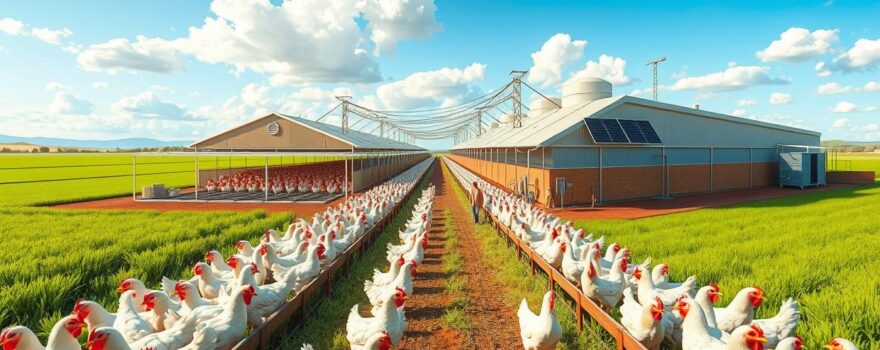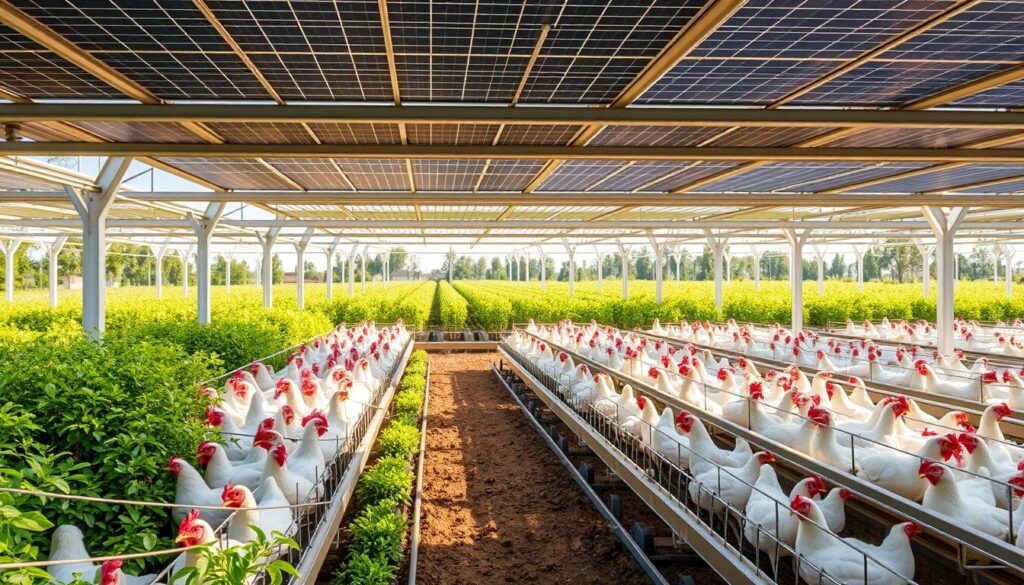
The poultry industry has grown a lot in recent years. Broiler production in the United States has seen about 2% growth each year since 2000. By 2022, people in the U.S. were eating 100 pounds of chicken each, making it the top animal protein.
This growth is thanks to the industry’s low costs and its ability to change with the market. This is because the poultry supply chain is fully integrated.
As the broiler chicken industry keeps changing, farmers need to keep up to stay ahead. They face challenges like changing costs and contract issues. They also have to deal with new problems like heat stress.
To succeed, farmers must understand the latest trends and be ready to try new things. This means knowing how to handle market changes and finding ways to stay profitable.
Key Takeaways
- The broiler chicken industry has experienced steady growth, with chicken becoming the most consumed animal protein in the United States.
- Vertical integration and contract growing have contributed to the industry’s flexibility and low production costs.
- Adapting to market changes, such as rising costs and evolving contract dynamics, is crucial for broiler producers to maintain profitability.
- Addressing emerging challenges, like heat stress, requires strategic adjustments to farming practices and infrastructure.
- Embracing genetic improvements, energy-efficient technologies, and sustainable feed sources can help broiler farmers optimize their operations.
The Poultry Industry’s Rising Prominence
The broiler chicken farming industry has grown a lot in the last ten years. It’s now a key part of the world’s food system. This growth is thanks to new Broiler Chicken Farming Best Practices, Sustainable Broiler Farming Strategies, and Innovative Broiler Farming Techniques.
Vertical Integration and Contract Growing
Vertical integration has been a big help to the poultry industry. Companies now control everything from hatcheries to processing plants. They also work with independent farmers (growers) through contract growing.
This setup helps both sides. Companies save money, and growers don’t face as many risks. Industry leaders like JBS S.A., Tyson Foods Inc., and BRF make billions of dollars each year. This shows how big and important the industry is.
The market offers a variety of products, from raw to processed. This meets different consumer needs and helps with distribution.
| Company | Annual Sales Revenue (in billion USD) |
|---|---|
| JBS S.A. | $50 |
| Tyson Foods Inc. | $47 |
| BRF | $7 |
The poultry industry plays a big role in feeding the world. It also changes with what people want and the economy. New ways of feeding chickens and making decisions with data have made it more efficient and profitable.
Escalating Costs of Poultry Farm Construction
The poultry industry is facing a big challenge with rising construction costs for new broiler farms. In the early 2000s, building a broiler farm cost between $10 and $12 per square foot. Now, it costs an astonishing $18 to $22 per square foot.
This huge jump is due to higher material, labor costs, and the need for bigger, tech-savvy barns. The high costs make it hard for many farmers to start, leading to more large farms owned by companies rather than families.
| Cost per Square Foot | Early 2000s | Current |
|---|---|---|
| Broiler Farm Construction | $10 – $12 | $18 – $22 |
The OECD-FAO Agricultural Outlook 2021–2030 shows that these rising costs will hit the broiler chicken farming sector hard. Since Poultry is currently the least expensive animal protein in the United States, farmers struggle to raise prices for consumers.
To help, some poultry companies give extra funds to growers to cover construction costs. They also offer longer loan terms, up to 20 years, to ease payments. But, banks still require a minimum debt service margin of 1.30, which is a hurdle.
As the poultry industry grows, Optimizing Broiler Farm Operations, Improving Broiler Farm Profitability, and good Broiler Farm Business Management are key. They will help farmers and the industry deal with these high costs.
Evolving Contract Dynamics
In the poultry industry, contract growers are key players. Their contracts with poultry companies are always changing. This brings both challenges and chances for growth. Growers get help with risks, but face big issues like high utility costs and old, special facilities.
Addressing Grower Concerns
Growers worry about their earnings due to contract changes. This makes their future less certain. They face Broiler Contract Farming Challenges like:
- High utility costs that eat into their profits
- Old, special facilities that are expensive to fix or replace
- Dealing with Poultry Grower Legal Issues from contract disputes or changes
As Broiler Farming Trends change, it’s vital for companies and growers to work together. They need to find ways to make the contract system fair and sustainable for everyone.

“The contract grower is the backbone of the vertically integrated poultry system, but the contracts must evolve to provide more stability and fairness for these essential partners.”
How to Adapt to Changing Market Conditions in Broiler Chicken Farming
The broiler chicken farming industry is facing many challenges. To stay ahead, producers need to use sustainable farming methods. They must also optimize their operations and manage their businesses well.
Improving the genetic traits of broiler chickens is key. This helps them handle heat and cold better. By adapting to genetic changes, farmers can improve efficiency and quality.
Optimizing farming practices and infrastructure is also vital. Lowering the initial placement temperature can save gas. Using cooling pads and fogging systems can also save energy and protect the environment.
Finding sustainable feed sources is another important step. As climate change affects crop yields, farmers need to find new protein and energy sources. This ensures their operations can last long-term.
“The rise in avian influenza incidence in Europe highlights the need for comprehensive disease management strategies, including potential vaccination, to prevent mass slaughters driven by climate change.”
By using these strategies, optimizing operations, and managing businesses well, farmers can adapt to market changes. This helps them remain the top choice for animal protein in the United States.
Genetic Improvements for Heat and Cold Tolerance
The world is facing big challenges from climate change. The poultry industry is under pressure to adapt. Broiler chickens and layers are getting more stressed from heat, which hurts their work and quality.
Researchers are working on new ways to make these birds more resistant to heat and cold. This could make the poultry sector more resilient and adaptable.
One way is through selective breeding for Broiler Chicken Genetic Adaptations. Breeders are looking for traits like better heat handling. This could lead to Thermotolerant Broiler Chicken that can handle changing climates better.
They’re also looking into early heat acclimation. This is a method to make Heat and Cold Stress Resilience in Broilers from a young age.
“Genetic advancements have been developed to breed poultry with increased heat tolerance while maintaining productivity to address heat stress challenges in poultry farming.”
These genetic improvements aim to make birds more resilient in both hot and cold. This ensures the poultry industry can keep up with unpredictable weather and climate shifts.
By using these new genetic techniques, poultry farmers can face the future better. This will protect the industry’s productivity, sustainability, and profits over time.
Optimizing Farming Practices and Infrastructure
The broiler chicken farming industry is changing fast. It’s important to focus on better farming and building designs. This means looking into new cooling methods, better ventilation and insulation, and using energy-efficient heating systems. These steps help make the Sustainable Broiler Farm Design and Energy-Efficient Poultry Housing better.
Energy Efficiency and Sustainability
Using evaporative cooling is a smart move. It involves sprinkling water on the birds to cool them down. Also, thinking about the farm’s layout and adding plants can make it more Environmentally-Friendly Broiler Production. This improves energy use and makes the farm more sustainable.
Using heat from exhaust air and switching to efficient heating can save a lot of money. This makes broiler farming more profitable. By improving the farm’s setup, producers can stay competitive and protect the environment.

“Adaptability and innovation are the keys to success in the ever-changing broiler chicken farming industry. By optimizing our farming practices and infrastructure, we can achieve greater energy efficiency and sustainability, ultimately benefiting both our business and the environment.”
Combating Emerging Diseases and Pests
The poultry industry faces new challenges from diseases and pests. Climate change has brought new pathogens and parasites to areas they once avoided. For example, Avian Influenza (AI) cases in Europe have skyrocketed. Tropical poultry mites could become a bigger problem as backyard farming grows.
To keep broiler chicken farms healthy, Poultry Disease Management and Poultry Pest Mitigation are key. This might mean more vaccinations, new pest control methods, and better industry coordination. It’s all about protecting animals and people.
| Pest Species | Characteristics | Risks |
|---|---|---|
| House Fly (Musca domestica) |
|
Potential disease transmission and nuisance to both livestock and humans |
| Little House Fly (Fannia canicularis) |
|
Can be a secondary pest, potentially contributing to disease transmission |
By keeping up with the latest Poultry Disease Management and Avian Influenza Control strategies, farmers can tackle these challenges. This helps keep their flocks healthy and productive.
“Addressing these emerging challenges will require a multifaceted approach, including the potential need for increased vaccination, the development of alternative pest control methods, and greater coordination within the industry to ensure the health and safety of both animals and humans.”
Sustainable Feed Sources and Dietary Adaptations
The poultry industry is changing, and finding sustainable poultry nutrition is key. Researchers are looking into alternative protein sources like forage crops, seaweed, and insects. These environmentally-friendly broiler feeds could be better for the planet and the birds.
Exploring Alternatives
Feed for chickens hasn’t changed much since the 1950s. A lot of energy is lost as heat. Also, not all amino acids are considered in feed, which can be costly.
There’s a need for better understanding in feed formulation. A study with 576 chicks showed promising results. They found that certain alternative proteins led to better growth and efficiency.
| Diet | Body Weight (g) | European Performance Efficiency Factor | Economic Efficiency |
|---|---|---|---|
| APS21 | 2,700 | 372 | 0.57 |
| APS20 | 2,680 | 365 | 0.54 |
| CTL19 | 2,620 | 354 | 0.51 |
This study shows that alternative proteins can make better chicken feed. It’s a step towards a more sustainable future for the poultry industry.
The broiler chicken farming industry is facing many challenges. These include rising construction costs and changing contracts. Climate change also has a big impact.
To overcome these challenges, the industry needs a complete plan. This plan should cover Broiler Farming Adaptation Strategies, Sustainable Poultry Industry Practices, and the Future of Broiler Chicken Farming.
Improving chicken genetics for better heat and cold tolerance is key. So is optimizing farming and infrastructure. Fighting diseases and pests and finding sustainable feed are also crucial.
This approach will help the poultry industry meet the world’s growing demand for chicken. It will also reduce the industry’s environmental impact. This way, broiler chicken farming can stay strong and important for food production.
The industry must stay quick and flexible to face these challenges. It should use the latest technology, research, and sustainable practices. This will help ensure a profitable and sustainable future for broiler chicken farming.
Together, these efforts will keep providing a reliable and nutritious protein source to people everywhere.